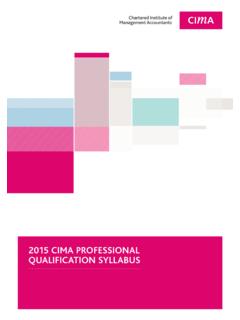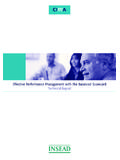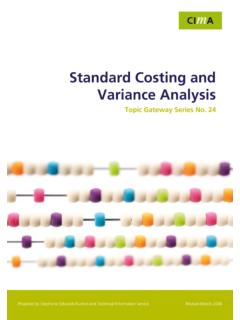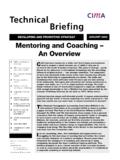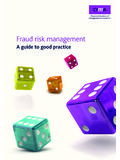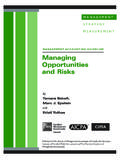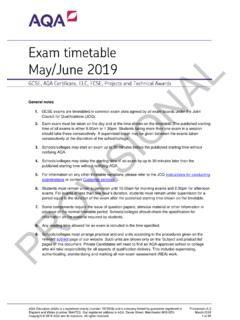Transcription of Step four: Make any other adjustments for
1 1 PAPER F1 FINANCIAL OPERATIONS CONSOLIDATED ACCOUNTS PART TWO By Jo Amos, F1 tutor and marker In the previous article we looked at the general principle of consolidated accounts, in particular the consolidated statement of financial position (SOFP). In this article we are going to move onto the consolidated income statement (IS) and then look at the SOFP and IS together as a potential examination question. Let us now look at the techniques used to consolidate the IS. Basic consolidation techniques As explained in the previous article it is important to first identify the group structure, as once again we only consolidate the parent and subsidiary, NOT the associate.
2 Again we will be applying the single entity concept. Hence consolidation should be: Parent + subsidiary +/-any adjustments Step one: Identify the group structure, which company is the subsidiary? Which company is the associate? How much control do we have in the associate? Step two: Eliminate any intra-group sales between the parent and subsidiary, NOT the associate. This will result in: Revenue Cost of sales Step three: Eliminate any unrealised profit in closing inventory from intra-group sales. This will result in: Cost of sales Remember: closing inventory is reducing, hence causing cost of sales to increase.
3 Step four: Make any other adjustments for current year additional depreciation due to any fair value adjustments or current year impairment. Expenses (could be cost of sales/administration/distribution follow examiners instructions or use the most appropriate) Step five: Remove any intra-group interest relating to intra-group loans between the parent and subsidiary. Investment income Finance costs Step six: Remove any intra-group dividends. Investment income Step seven: Calculate the share of associate profit and add to the group profit. Example: The income statements are given for the Music group for the year ended 31 December 2010.
4 Pop Rock Classical $000 $000 $000 Income Statements Revenue 120,000 90,000 84,000 Cost of sales (60,000) (45,000) (42,000) Gross profit 60,000 45,000 42,000 other operating expenses (18,000) (9,000) (4,200) Profit from operations 42,000 36,000 37,800 Investment income 18,600 4,500 Finance costs (6,000) (4,500) (2,100) Profit before tax 54,600 36,000 35,700 Taxation (15,200) (11,000) (4,800) Profit for the year 39,400 25,000 30,900 Pop owns all the shares in Rock and 40% of the shares in Classical.
5 Pop has provided each company with a loan of $10 million at an interest rate of 10%. Both loans have been outstanding throughout the period. When Pop acquired Rock the fair value of its net assets were $1,000,000 higher than its 2 carrying value. This related to a building which had an estimated future useful life of 5 years at the date of acquisition. Pop supplies a component which is used as a raw material by Rock and Classical. During the year ended 31 December 2010, sales of such components by Pop to Rock were $800,000 and by Pop to Classical $600,000. The inventories of the above-mentioned raw material were included in the accounts of Rock at 31 December 2010 at cost to Rock of $600,000.
6 Classical held no inventory purchased from Pop at the year end. Pop marks up all sales to Rock and Classical by 25%. During the year there was no impairment of goodwill or intra-group dividends paid. We can now follow the steps to consolidate as follows: Step one: Identify the group structure, Rock is the subsidiary and Classical is the associate (40%) Step two: Eliminate any intra-group sales between the parent and subsidiary, NOT the associate. This will result in: Revenue $800,000 Cost of sales $800,000 Step three: Eliminate any unrealised profit in closing inventory from intra-group sales.
7 We do not have any closing inventory in the associate, hence no unrealised profit. The unrealised profit is calculated using the mark-up method $600,000/125 x 25 =$120,000 This will result in: Cost of sales $120,000 Step four: Increase our expenses by the additional depreciation charge of $1,000,000/5 = $200,000 for the year. Expenses (cost of sales) We do not have any impairment for the year. Step five: Eliminate the intra-group loan interest between the parent and subsidiary, NOT the associate, of $10,000,000 x 10% = $1,000,000. Investment income $1,000,000 Finance costs $1,000,000 Step six: We do not have any intra-group dividends for the year.
8 Step seven: The share of associate profit for the year will be $30,900,000 x 40% = $12,360,000 We can now consolidate. Remember: we are only adding together the parent and subsidiary and introducing the workings we have made above. Consolidated income statement for the Music Group for the year ended 31 December 2010 $000 Income Statements Revenue (120,000 + 90,000 800) 209,200 Cost of sales (60,000 + 45,000 800 + 120 + 200) (104,520) Gross profit 104,680 Operating expenses (18,000 + 9,000) (27,000) Profit from operations 77,680 Investment income(18,600 + 4,500 1,000) 22,100 Finance costs (6,000 + 4,500 1,000) (9,500) Share of associate profit 12,360 Profit before tax 102,640 Taxation (15,200 + 11,000) (26,200)
9 Profit for the year 76,440 Exam approach to consolidate the IS: 1. Set out your proforma as per the question, inserting a line below the operating profit for profit in the associate. 3 2. Add together all income and expenditure items for the parent and subsidiary in brackets. 3. Prepare any additional workings required. 4. Consolidate. REMEMBER: DO NOT CONSOLIDATE THE ASSOCIATE! 4 Now we have looked at consolidating both the IS and SOFP, let us look at an exam style question incorporating them both. Fully worked example: The Waterloo Group of Grantly and its investee companies Clo and Donte at 31 May 2010 are shown below.
10 Draft Income Statements for the year ended 31 May 2010 Grantly Clo Donte $000 $000 $000 Revenue 1,138 488 149 Cost of sales (576) (214) (59) _____ _____ _____ Gross profit 562 274 90 other operating expenses (138) (54) (40) _____ _____ _____ Profit from operations 424 220 50 Interest payable (38) (44) (14) _____ _____ _____ Profit before tax 386 176 36 Taxation (54) (24) (6) _____ _____ _____ Profit for the year 332 152 30 _____ _____ _____ Draft Statements of financial position as at 31 May 2010 Grantly Clo Donte $000 $000 $000 $000 $000 $000 Non-current assets PPE 690 812 712 Investments 1,950 - - ____ ____ ____ 2,640 812 712 Current assets Inventories 700 594 56 Receivables 1,000 180 130 Cash and cash equivalents 375 25 15 ____ ____ ____ 2,075 799 201 ____ ____ ____ 4,715 1,611 913 ____ ____ ____ Equity Share capital ($1 ordinary shares)
